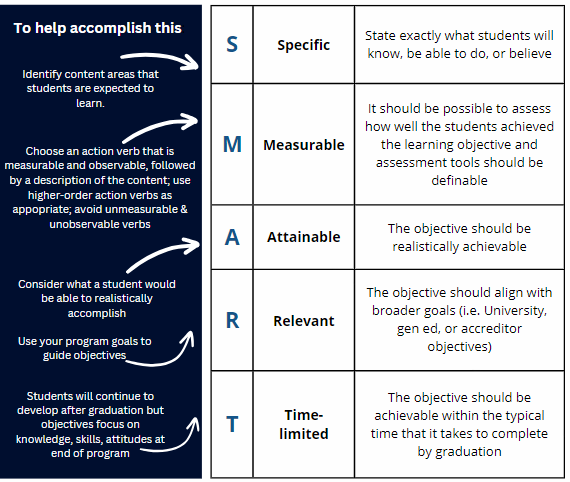A learning objective contains four parts. Each part means nothing when viewed separately but when combined articulates the learning objective. Once developed the objective contains who will be learning, the conditions under which the behavior is performed or measured, a verb that defines the behavior, and the criteria under which and/or degree to which a student must perform the behavior.
The 4 parts of a learning objective are often represented using the ABCD (audience, behavior, condition, and degree) model:
Audience: Who is the target audience? The most common audiences identified in learning objectives are students, learners, participants, or attendees.
Behavior: What is the real work to be accomplished by the student? This is an action verb that connotes an observable and measurable behavior. Selection of an observable and measurable behavior can be challenging.
One way to identify a verb is to ask:
How will I know that the student has gained the knowledge, can accomplish the skill, or possesses an attitude?
What does it look like?
What assessment tools will measure it or make it observable?
Despite their frequent use in objectives, terms such as know, understand, enjoy, and appreciate are difficult to observe or measure. In contrast, verbs such as write, compare, contrast, build, identify, and recite are measurable and observable because it is possible to identify how we know a student has developed the desired knowledge, skills, or attitudes.
Condition: What are the conditions/constraints within which the audience will be expected to perform these tasks? This is a statement that describes the exact conditions under which the defined behavior is to be performed. The conditions statement should include information about what tools, aids, or assistance will be provided or denied. When writing program-level objectives, sometimes this is not included because a program-level objective is evaluated using multiple measures of assessment.
Degree: How will the behavior need to be performed? This is a statement that specifies how well the student must perform the behavior, such as the degree of accuracy or the quantity or proportion of correct responses. For some learning objectives, this criterion will not be listed, rather it is implied.

When describing what a student will know, be able to do, and what attitudes will be gained, an effective learning objective meets the mnemonic SMART. It specifically states measurable descriptions of what the students will realistically achieve by the time they finish the program.

To help accomplish this, consider these questions:
- What content areas and topics are students expected to learn?
- What measurable and observable action verb describes what the student will know, be able to do, or attitudes they will possess?
- Can a higher-order action verb (one that describes critical or creative thinking) be used?
- How a student will demonstrate what they know, can do, or believe?
Beware of unmeasurable and unobservable verbs such as understand, use, know, learn, appreciate, believe, enjoy, grasp the significance of, have an awareness of, be familiar with, and comprehend as they are difficult to observe or demonstrate.